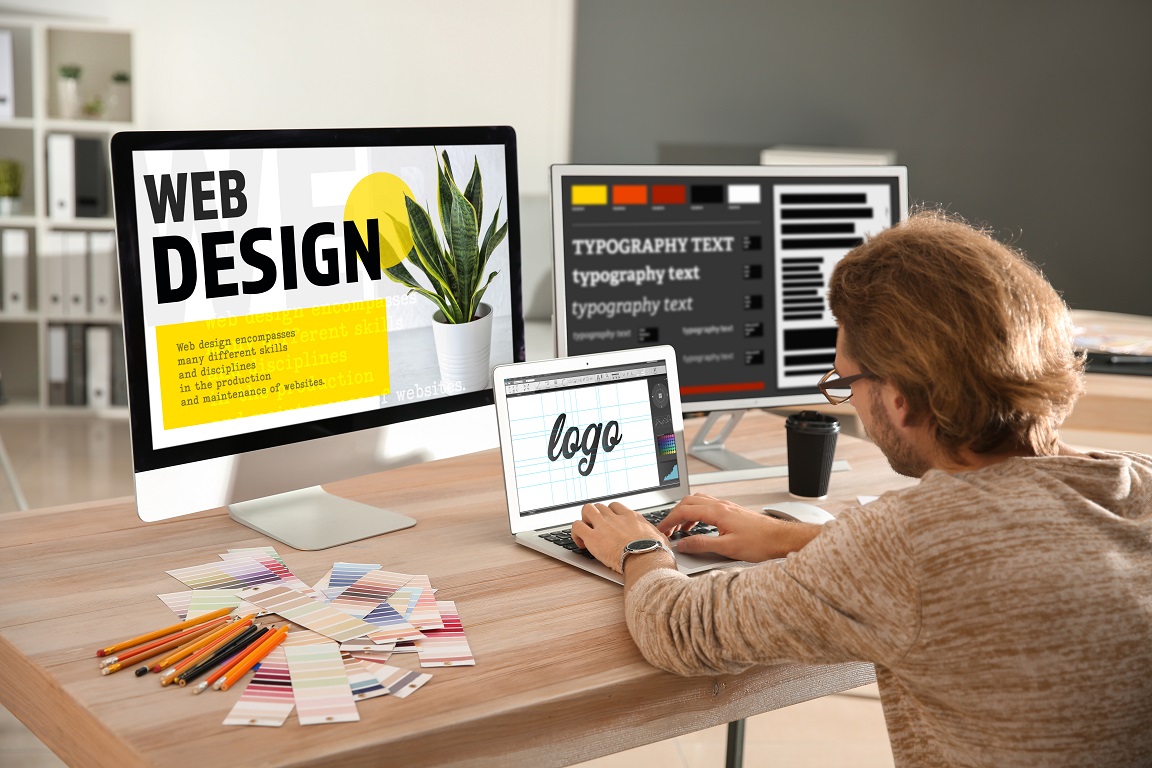Five signs it’s time to partner with a Website Design Agency
Wiki Article
The Significance of User Experience in Effective Web Design Strategies
User experience (UX) offers as a cornerstone in reliable web design methods. It shapes just how users interact with a site, influencing their fulfillment and probability of returning. A well-designed UX can enhance involvement through intuitive navigation and responsive formats. Ignoring these elements may lead to aggravation and boosted bounce prices. Comprehending the intricacies of UX is crucial for designers intending to create engaging electronic experiences that resonate with varied audiences. What factors really drive successful user engagement?Recognizing User Experience and Its Effect On Design
User experience (UX) is frequently viewed as a simple element of internet style, it essentially shapes exactly how individuals interact with a site. UX encompasses all elements of the user's interaction, including use, access, and general fulfillment. A positive UX cultivates engagement, motivating users to check out the website and return in the future. Conversely, an unfavorable experience can cause frustration, resulting in high bounce prices and shed possibilities for conversion.Layout aspects like material, format, and navigating organization play essential functions in shaping this experience. Efficient UX design expects user requirements and preferences, making sure that info is easily accessible and visually appealing. In addition, recognizing user behavior through analytics can give important understandings, educating design decisions that enhance usability. Inevitably, an extensive understanding of UX allows developers to create websites that not only bring in users yet additionally promote meaningful communications that straighten with organization goals and user expectations.
Secret Principles of Reliable User Experience
Reliable user experience rests on numerous crucial principles that improve web site functionality and interaction. User-friendly navigation design, responsive layout fundamentals, and the relevance of visual power structure are essential elements that contribute to a seamless communication in between users and internet content. Understanding these principles permits designers to develop even more available and easy to use digital environments.Instinctive Navigating Style
Instinctive navigating layout serves as a crucial entrance to their general experience when users come across an internet site. Efficient navigating permits customers to easily situate the details they seek, improving their interaction with the website. Trick concepts consist of clear labeling, logical company, and consistent placement of navigation elements. Tags need to be simple, allowing customers to predict the material they will locate. A well-structured pecking order helps users recognize the connection in between different sections, guiding them through the website seamlessly. Furthermore, receptive food selections and conveniently accessible links add to a fluid experience across devices. By prioritizing user-friendly navigation, designers can considerably minimize user irritation and increase engagement, inevitably fostering a favorable perception of the internet site and its web content.Responsive Layout Fundamentals
A well-structured navigation system naturally results in the need for a receptive layout, which is vital in today's diverse digital landscape. A responsive layout warranties that websites function flawlessly throughout various devices, including desktops, smartphones, and tablet computers. This versatility enhances user experience by allowing content to be aesthetically coherent and quickly obtainable, despite display size. Secret concepts of responsive style consist of liquid grids, versatile images, and media queries, which facilitate optimal watching. Furthermore, prioritizing touch-friendly elements enhances interaction on mobile phones. By applying a receptive design, developers can accommodate customers' needs, minimize bounce rates, and increase interaction. Inevitably, a well-executed receptive layout fosters a favorable user experience, encouraging site visitors to check out the site additionally.Visual Power Structure Importance
Aesthetic hierarchy plays a necessary function in leading customers via a website, making certain that crucial details records their interest. By tactically making use of size, shade, spacing, and comparison, developers can create a clear path for users to comply with. Bigger aspects frequently attract the eye, suggesting their value, while contrasting colors can highlight phone call to activity. Additionally, constant alignment and group of related web content improve comprehension, making navigating intuitive. Efficient usage of aesthetic hierarchy not just boosts usability but also sustains the total visual of the website, cultivating a positive user experience. When customers can conveniently identify the most essential information, they are a lot more likely to engage with the web content, causing boosted contentment and communication with the web site.The Role of Functionality in Web Design
Functionality plays a necessary duty in web design, specifically through navigation simpleness and adherence to access requirements. Reliable navigating enhances user satisfaction by permitting visitors to find information promptly and without effort. Conference accessibility standards guarantees that all customers, regardless of their abilities, can effectively connect with the website.Navigation Simpleness
Simplicity in navigation stands as a keystone of effective web design, greatly affecting user experience. A streamlined navigation system permits individuals to locate details rapidly and intuitively, minimizing frustration and boosting contentment. Clear labeling and sensible framework are crucial elements, assisting customers effortlessly with the site. Redundant links or extremely complicated menus can disorient individuals, resulting in raised bounce rates. Additionally, mobile responsiveness must be thought about, ensuring navigating stays straightforward throughout devices. Focusing on essential pages and decreasing clutter further sustains user involvement. Effective navigating not only promotes a positive experience but additionally encourages users to discover the website more completely, ultimately bring about higher conversion rates. Hereof, navigating simpleness functions as a vital element in the general effectiveness of web design techniques.Access Criteria
User engagement is significantly boosted when web sites follow accessibility criteria, making certain that all customers, regardless of their capabilities, can navigate and communicate successfully. Conformity with these requirements not just widens the target market yet likewise enhances general user fulfillment. Obtainable layout integrates attributes such as message alternatives for pictures, key-board navigating, and enough shade comparison, which help with use by people with impairments. On top of that, executing these standards can favorably influence search engine optimization (SEO) by boosting site framework and quality. As web design develops, prioritizing ease of access ends up being important in fostering a comprehensive digital setting. By welcoming these criteria, developers add to an extra fair net, inevitably driving user commitment and involvement.Importance of Responsive Layout for User Involvement
As consumers increasingly accessibility sites via a selection of devices, the importance of receptive design ends up being critical for engaging customers effectively. Receptive style guarantees that a web site adapts seamlessly to different screen dimensions, supplying a perfect viewing experience despite the gadget utilized. This adaptability improves user interaction by helping with much easier navigation and interaction with content.When customers run into a website go right here that is responsive, they are a lot more most likely to stay much longer, discover additionally, and return in the future. A properly designed responsive layout reduces the disappointment often connected with scrolling and zooming on smaller displays, thereby lowering bounce rates. Furthermore, receptive layout can favorably affect search engine rankings, as internet search engine prioritize mobile-friendly sites. In today's electronic landscape, where mobile usage remains to rise, implementing responsive layout is not simply valuable, but essential for maintaining user engagement and guaranteeing a positive experience throughout all gadgets.
Enhancing Load Times for Better User Complete Satisfaction

To improve load times, web designers ought to prioritize maximizing images, leveraging web browser caching, and minimizing HTTP demands. In addition, employing Content Distribution Networks (CDNs) can quicken material shipment by dispersing it across different geographical areas. Improving code, such as compressing CSS and JavaScript files, better contributes to faster loading speeds.
Inevitably, a dedication to enhancing tons times not only boosts user fulfillment however also reinforces brand commitment and improves the chance of repeat visits. A swift, smooth experience is necessary for maintaining individuals and cultivating positive interactions.
The Influence of Visual Power Structure on User Communication
Aesthetic power structure works as an essential element in directing user communication on a website. By organizing material in a manner that prioritizes info aesthetically, developers can influence just how individuals navigate and involve with a website. This pecking order is established through numerous design strategies, including size, color, contrast, and spacing. Larger font styles or vibrant colors attract focus to crucial elements, such as calls to activity or headings, while suppressed colors and smaller fonts can show secondary info.Effective aesthetic hierarchy helps individuals swiftly recognize what is essential, lowering cognitive tons and boosting use. It permits user-friendly navigating, making it easier for users to discover what they require without frustration. As individuals engage with a web site, a well-structured visual pecking order cultivates a more rewarding experience, inevitably leading to higher interaction and conversion prices. Developers have to focus on these concepts to produce a effective and user-centered web atmosphere.
Gauging User Experience: Tools and Methods

Frequently Asked Concerns
Just How Can I Enhance My Website's User Experience on a Budget plan?
To improve a web site's user experience on a spending plan, one can optimize page tons rate, simplify navigation, carry out receptive design, enhance content quality, and collect user feedback for continual refinements, making sure an enjoyable visitor experience.What Prevail User Experience Blunders to Stay Clear Of in Web Design?
Typical user experience blunders in web design include messy designs, bad navigation, sluggish loading times, lack of mobile responsiveness, neglecting availability, irregular branding, and stopping working to prioritize user feedback - Web Design services. Each can considerably prevent total website efficiency
Just how Typically Should I Update My Web Site for Better User Experience?
Internet sites should be updated consistently, preferably every few months, to preserve ideal user experience. Frequent updates help address functionality problems, revitalize material, and adapt to transforming user requirements, making certain the website continues to be interesting and appropriate.
Can User Experience Influence SEO Rankings on My Website?
User experience can substantially impact search engine optimization positions, as search engines focus on websites that supply seamless navigating, fast packing times, and interesting content. A favorable user experience can bring about lower bounce rates and higher search visibility.What Duty Does Availability Play in User Experience Design?
Accessibility plays a crucial duty in user experience design by guaranteeing that all individuals, despite capacities, can navigate and engage with a website efficiently. This inclusivity improves total complete satisfaction and involvement amongst varied users.User experience (UX) is typically regarded as a mere Full Article element of web layout, it essentially forms how individuals engage with a site. User engagement is considerably boosted when websites stick to accessibility requirements, guaranteeing that all individuals, regardless of their capacities, can browse and interact properly. Measuring user experience (UX) is essential for recognizing how effectively an internet site meets the needs of its customers. In addition, usability screening, where genuine customers browse the website while onlookers keep in mind problems, offers direct feedback on user experience. Common user experience errors in web layout consist of cluttered formats, bad navigation, sluggish loading times, lack of mobile responsiveness, ignoring access, irregular branding, and falling short to focus on user feedback.
Report this wiki page